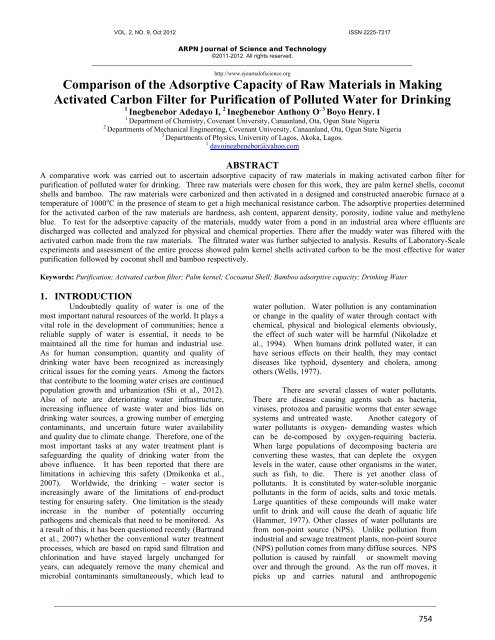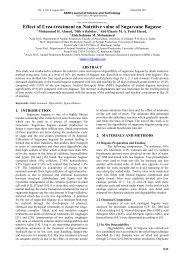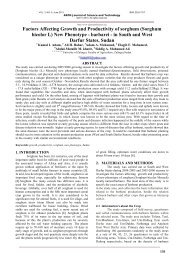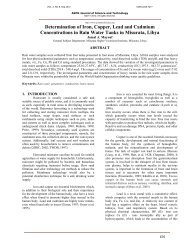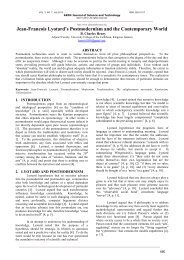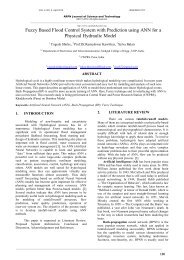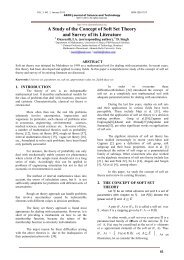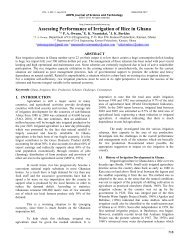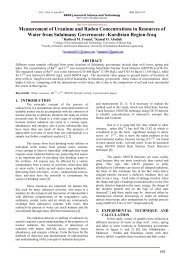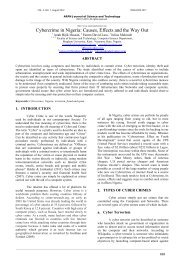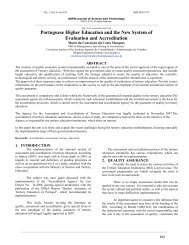ARPN Journal of Science and Technology::Comparison of the ...
ARPN Journal of Science and Technology::Comparison of the ...
ARPN Journal of Science and Technology::Comparison of the ...
Create successful ePaper yourself
Turn your PDF publications into a flip-book with our unique Google optimized e-Paper software.
VOL. 2, NO. 9, Oct 2012 ISSN 2225-7217<br />
<strong>ARPN</strong> <strong>Journal</strong> <strong>of</strong> <strong>Science</strong> <strong>and</strong> <strong>Technology</strong><br />
©2011-2012. All rights reserved.<br />
http://www.ejournal<strong>of</strong>science.org<br />
<strong>Comparison</strong> <strong>of</strong> <strong>the</strong> Adsorptive Capacity <strong>of</strong> Raw Materials in Making<br />
Activated Carbon Filter for Purification <strong>of</strong> Polluted Water for Drinking<br />
1<br />
Inegbenebor Adedayo I, 2 Inegbenebor Anthony O , 3 Boyo Henry. I<br />
1<br />
Department <strong>of</strong> Chemistry, Covenant University, Canaanl<strong>and</strong>, Ota, Ogun State Nigeria<br />
2<br />
Departments <strong>of</strong> Mechanical Engineering, Covenant University, Canaanl<strong>and</strong>, Ota, Ogun State Nigeria<br />
3<br />
Departments <strong>of</strong> Physics, University <strong>of</strong> Lagos, Akoka, Lagos.<br />
1 dayoinegbenebor@yahoo.com<br />
ABSTRACT<br />
A comparative work was carried out to ascertain adsorptive capacity <strong>of</strong> raw materials in making activated carbon filter for<br />
purification <strong>of</strong> polluted water for drinking. Three raw materials were chosen for this work, <strong>the</strong>y are palm kernel shells, coconut<br />
shells <strong>and</strong> bamboo. The raw materials were carbonized <strong>and</strong> <strong>the</strong>n activated in a designed <strong>and</strong> constructed anaerobic furnace at a<br />
temperature <strong>of</strong> 1000 o C in <strong>the</strong> presence <strong>of</strong> steam to get a high mechanical resistance carbon. The adsorptive properties determined<br />
for <strong>the</strong> activated carbon <strong>of</strong> <strong>the</strong> raw materials are hardness, ash content, apparent density, porosity, iodine value <strong>and</strong> methylene<br />
blue. To test for <strong>the</strong> adsorptive capacity <strong>of</strong> <strong>the</strong> materials, muddy water from a pond in an industrial area where effluents are<br />
discharged was collected <strong>and</strong> analyzed for physical <strong>and</strong> chemical properties. There after <strong>the</strong> muddy water was filtered with <strong>the</strong><br />
activated carbon made from <strong>the</strong> raw materials. The filtrated water was fur<strong>the</strong>r subjected to analysis. Results <strong>of</strong> Laboratory-Scale<br />
experiments <strong>and</strong> assessment <strong>of</strong> <strong>the</strong> entire process showed palm kernel shells activated carbon to be <strong>the</strong> most effective for water<br />
purification followed by coconut shell <strong>and</strong> bamboo respectively.<br />
Keywords: Purification; Activated carbon filter; Palm kernel; Cocoanut Shell; Bamboo adsorptive capacity; Drinking Water<br />
1. INTRODUCTION<br />
Undoubtedly quality <strong>of</strong> water is one <strong>of</strong> <strong>the</strong><br />
most important natural resources <strong>of</strong> <strong>the</strong> world. It plays a<br />
vital role in <strong>the</strong> development <strong>of</strong> communities; hence a<br />
reliable supply <strong>of</strong> water is essential, it needs to be<br />
maintained all <strong>the</strong> time for human <strong>and</strong> industrial use.<br />
As for human consumption, quantity <strong>and</strong> quality <strong>of</strong><br />
drinking water have been recognized as increasingly<br />
critical issues for <strong>the</strong> coming years. Among <strong>the</strong> factors<br />
that contribute to <strong>the</strong> looming water crises are continued<br />
population growth <strong>and</strong> urbanization (Shi et al., 2012).<br />
Also <strong>of</strong> note are deteriorating water infrastructure,<br />
increasing influence <strong>of</strong> waste water <strong>and</strong> bios lids on<br />
drinking water sources, a growing number <strong>of</strong> emerging<br />
contaminants, <strong>and</strong> uncertain future water availability<br />
<strong>and</strong> quality due to climate change. Therefore, one <strong>of</strong> <strong>the</strong><br />
most important tasks at any water treatment plant is<br />
safeguarding <strong>the</strong> quality <strong>of</strong> drinking water from <strong>the</strong><br />
above influence. It has been reported that <strong>the</strong>re are<br />
limitations in achieving this safety (Dmikonka et al.,<br />
2007). Worldwide, <strong>the</strong> drinking – water sector is<br />
increasingly aware <strong>of</strong> <strong>the</strong> limitations <strong>of</strong> end-product<br />
testing for ensuring safety. One limitation is <strong>the</strong> steady<br />
increase in <strong>the</strong> number <strong>of</strong> potentially occurring<br />
pathogens <strong>and</strong> chemicals that need to be monitored. As<br />
a result <strong>of</strong> this, it has been questioned recently (Bartr<strong>and</strong><br />
et al., 2007) whe<strong>the</strong>r <strong>the</strong> conventional water treatment<br />
processes, which are based on rapid s<strong>and</strong> filtration <strong>and</strong><br />
chlorination <strong>and</strong> have stayed largely unchanged for<br />
years, can adequately remove <strong>the</strong> many chemical <strong>and</strong><br />
microbial contaminants simultaneously, which lead to<br />
water pollution. Water pollution is any contamination<br />
or change in <strong>the</strong> quality <strong>of</strong> water through contact with<br />
chemical, physical <strong>and</strong> biological elements obviously,<br />
<strong>the</strong> effect <strong>of</strong> such water will be harmful (Nikoladze et<br />
al., 1994). When humans drink polluted water, it can<br />
have serious effects on <strong>the</strong>ir health, <strong>the</strong>y may contact<br />
diseases like typhoid, dysentery <strong>and</strong> cholera, among<br />
o<strong>the</strong>rs (Wells, 1977).<br />
There are several classes <strong>of</strong> water pollutants.<br />
There are disease causing agents such as bacteria,<br />
viruses, protozoa <strong>and</strong> parasitic worms that enter sewage<br />
systems <strong>and</strong> untreated waste. Ano<strong>the</strong>r category <strong>of</strong><br />
water pollutants is oxygen- dem<strong>and</strong>ing wastes which<br />
can be de-composed by oxygen-requiring bacteria.<br />
When large populations <strong>of</strong> decomposing bacteria are<br />
converting <strong>the</strong>se wastes, that can deplete <strong>the</strong> oxygen<br />
levels in <strong>the</strong> water, cause o<strong>the</strong>r organisms in <strong>the</strong> water,<br />
such as fish, to die. There is yet ano<strong>the</strong>r class <strong>of</strong><br />
pollutants. It is constituted by water-soluble inorganic<br />
pollutants in <strong>the</strong> form <strong>of</strong> acids, salts <strong>and</strong> toxic metals.<br />
Large quantities <strong>of</strong> <strong>the</strong>se compounds will make water<br />
unfit to drink <strong>and</strong> will cause <strong>the</strong> death <strong>of</strong> aquatic life<br />
(Hammer, 1977). O<strong>the</strong>r classes <strong>of</strong> water pollutants are<br />
from non-point source (NPS). Unlike pollution from<br />
industrial <strong>and</strong> sewage treatment plants, non-point source<br />
(NPS) pollution comes from many diffuse sources. NPS<br />
pollution is caused by rainfall or snowmelt moving<br />
over <strong>and</strong> through <strong>the</strong> ground. As <strong>the</strong> run <strong>of</strong>f moves, it<br />
picks up <strong>and</strong> carries natural <strong>and</strong> anthropogenic<br />
754
VOL. 2, NO. 9, Oct 2012 ISSN 2225-7217<br />
<strong>ARPN</strong> <strong>Journal</strong> <strong>of</strong> <strong>Science</strong> <strong>and</strong> <strong>Technology</strong><br />
©2011-2012. All rights reserved.<br />
pollutants, finally depositing <strong>the</strong>m into lakes, rivers,<br />
wetl<strong>and</strong>s, coastal water <strong>and</strong> ground water systems<br />
(USEPA, 2003). Recently, studies conducted in China<br />
have shown that NPS is now an important issue in<br />
pollution <strong>of</strong> water environment, <strong>and</strong> that agricultural<br />
NPS poses <strong>the</strong> greatest risk (Ongley, 2010). With <strong>the</strong><br />
development <strong>of</strong> agriculture <strong>and</strong> <strong>the</strong> increasing amount <strong>of</strong><br />
chemical fertilizers <strong>and</strong> pesticides used in China <strong>and</strong><br />
o<strong>the</strong>r countries, <strong>the</strong> proportion <strong>of</strong> NPS pollution would<br />
increase annually. To this end, <strong>the</strong> research on<br />
agricultural non-point source pollution modeling was<br />
undertaken for improvements in development <strong>of</strong><br />
technology for controlling such system in China (Shen<br />
et al., 2012).<br />
http://www.ejournal<strong>of</strong>science.org<br />
matter in an incomplete state <strong>of</strong> decomposition.<br />
However, <strong>the</strong> use <strong>of</strong> activated carbon as a means <strong>of</strong><br />
eliminating tastes <strong>and</strong> odour has, in many cases, proved<br />
to be efficient improvement in purification (Dvorak <strong>and</strong><br />
Skipton, 2008). Purification ability depends on many<br />
things, including type <strong>of</strong> carbon that is available<br />
throughout <strong>the</strong> entire activation process. The surface <strong>of</strong><br />
<strong>the</strong> carbon is in square meters per gram <strong>and</strong> <strong>the</strong> pore<br />
structure (distribution <strong>of</strong> micro-, meso-<strong>and</strong> macro<br />
pores). Thus, <strong>the</strong> current work was designed to examine<br />
<strong>the</strong> comparison <strong>of</strong> <strong>the</strong> adsorptive capacity <strong>of</strong> <strong>the</strong> raw<br />
materials used to make activated carbon filter.<br />
2. MATERIALS AND METHODS<br />
As far as <strong>the</strong> inorganic <strong>and</strong> organic<br />
contaminants are concerned, <strong>the</strong> most important with<br />
regard to health are heavy metals (arsenic, lead,<br />
chromium, mercury, cadmium, etc), turbidity, organochlorine<br />
<strong>and</strong> organic phosphorus pesticides, polynuclear<br />
aromatic hydrocarbons (PAHs), polychlorinated<br />
biphenyls (PCBs) <strong>and</strong> disinfection by products (WHO,<br />
2004). Each type <strong>of</strong> raw water has a characteristic<br />
pollution pattern, <strong>and</strong> treatment must be related to <strong>the</strong><br />
source water quality <strong>and</strong> <strong>the</strong> desired end-product<br />
st<strong>and</strong>ards (WHO, 2003; AWWA, 1990). Since pollution<br />
seems inevitable in every society, water must be<br />
maintained for human consumption. This need is<br />
reflected in <strong>the</strong> growing market for home water filters<br />
which are designed to remove objectionable tastes,<br />
odours <strong>and</strong> organic contaminants from water.<br />
The material in <strong>the</strong>se activated carbon filters is<br />
recognized as effective <strong>and</strong> reliable in removing<br />
impurities (Aeppli <strong>and</strong> Dyer-Smith, 1999). Activated<br />
cabon has a tremendous absorbing capacity, for a wide<br />
variety <strong>of</strong> dissolved organics <strong>and</strong> chlorine <strong>and</strong> can be<br />
custom-tailored to suit specific application (Robert <strong>and</strong><br />
Mazzoni, 2008). Activated carbon, in granular (GAC)<br />
or powered (PAC) form, is commonly incorporated into<br />
filters used as home treatment devices. These devices<br />
can be fitted to service an entire home at <strong>the</strong> point <strong>of</strong><br />
entry or at a single faucet, with <strong>the</strong> latter termed point <strong>of</strong><br />
use (POU) devices. Activated carbon is a favored water<br />
treatment technique because <strong>of</strong> its multifunctional<br />
nature <strong>and</strong> <strong>the</strong> fact that it adds nothing detrimental to <strong>the</strong><br />
treated water (Desilva, 2000). Activated carbon is <strong>the</strong><br />
most popular <strong>and</strong> <strong>the</strong> cheapest material used in<br />
purification <strong>of</strong> water, <strong>and</strong> much <strong>of</strong> it is regenerated<br />
(cleaning/desorption) <strong>and</strong> is used hundreds or even<br />
thous<strong>and</strong>s <strong>of</strong> times. One <strong>of</strong> <strong>the</strong> most difficult problems<br />
encountered in water purification is that <strong>of</strong> taste, odour<br />
<strong>and</strong> color control. The usual taste <strong>and</strong> odour producing<br />
substances in water are probably represented by organic<br />
2.1 Raw Materials<br />
Most activated carbons are made from raw<br />
materials such as nut shells, wood, coal, coconut shell;<br />
bamboo, palm kernel shell <strong>and</strong> petroleum. The typical<br />
surface area for activated carbon is approximately 1,000<br />
square meters per gram (m 2 /gm). However, different<br />
raw materials produce different types <strong>of</strong> activated<br />
carbon varying in hardness, density, pore <strong>and</strong> particle<br />
sizes, surface areas, extractable ash <strong>and</strong> pH. These<br />
differences in properties make certain carbons<br />
preferable over o<strong>the</strong>rs in different applications. The two<br />
principal mechanisms by which activated carbon<br />
removes contaminants from water are adsorption <strong>and</strong><br />
catalytic reduction. Organics are removed by adsorption<br />
<strong>and</strong> residual disinfectants are removed by catalytic<br />
reduction. The base materials selected for this work are<br />
coconut shell, palm kernel shell <strong>and</strong> bamboo as wood.<br />
a. Coconut Shell (Cocos Nucifera)<br />
Arecaceae (palm family) is an agricultural crop<br />
that is wide spread in <strong>the</strong> tropics. The species has been<br />
cultivated for 400 years. The coconut tree comes from<br />
<strong>the</strong> south-east Asian Peninsula (probably Malaysia), but<br />
is cultivated in tropical regions all around <strong>the</strong> world.<br />
Coconut trees commonly grow on tropical beaches. A<br />
large plantation <strong>of</strong> coconut tree can be found in pacific,<br />
Indonesia, Philippines, South Asia, East <strong>and</strong> West<br />
Africa <strong>and</strong> <strong>the</strong> Caribbean. Based on <strong>the</strong>ir stem height,<br />
tall <strong>and</strong> dwarf varieties are distinguished. Presently<br />
over 100 varieties are known, about half <strong>of</strong> <strong>the</strong>m tall.<br />
Once tall palms, which can reach stem heights above<br />
20m, are 50-60 years old, <strong>the</strong>ir copra yield declines<br />
rapidly, <strong>and</strong> <strong>the</strong> question <strong>of</strong> replacement arises. The<br />
fruit from <strong>the</strong> coconut tree consists <strong>of</strong> <strong>the</strong> husk, <strong>the</strong> hard<br />
seed coat (ectosperm) which is <strong>the</strong> shell. The inside <strong>of</strong><br />
<strong>the</strong> endosperm has a pleasant, mild <strong>and</strong> nutty fragrance<br />
<strong>and</strong> a typical taste, with a hint <strong>of</strong> sweetness. The sour<br />
755
VOL. 2, NO. 9, Oct 2012 ISSN 2225-7217<br />
<strong>ARPN</strong> <strong>Journal</strong> <strong>of</strong> <strong>Science</strong> <strong>and</strong> <strong>Technology</strong><br />
©2011-2012. All rights reserved.<br />
liquid inside <strong>the</strong> seed is a common refresher in tropical<br />
countries.<br />
b. Palm kernel (Elaeis Guineensisn)<br />
The Palm kernel fruit comes from palm tree.<br />
Palm tree is a sub tropical evergreen <strong>of</strong> <strong>the</strong> proteeaceae<br />
family which grows in Hawaii, Nigeria, Malaysia <strong>and</strong><br />
Australia. It was proved to be suitable for large scale<br />
production <strong>of</strong> activated carbon. The nut from <strong>the</strong> palm<br />
tree has a husk which is red in colour, indicating<br />
maturity for use. It is very fatty <strong>and</strong> edible. The hard<br />
seed coat (ectosperm), what is a shell <strong>of</strong> 2mm to 3mm in<br />
thickness, is used for activated carbon.<br />
c. Bamboo (Bambuso Valgeris)<br />
The bamboo is a group <strong>of</strong> perennial evergreen<br />
(except for certain temperate species) plants in <strong>the</strong> true<br />
grass family poaceae, <strong>the</strong> sub family <strong>of</strong> this species is<br />
made up <strong>of</strong> bambusoideae, bambuseae <strong>and</strong> giant<br />
bamboos which are <strong>the</strong> largest members <strong>of</strong> <strong>the</strong> family.<br />
In bamboo, <strong>the</strong> intermodal regions <strong>of</strong> <strong>the</strong> plant stem are<br />
hollow, but <strong>the</strong> vascular bundles, as seen in cross<br />
section, are scattered throughout <strong>the</strong> stem instead <strong>of</strong> in a<br />
cylindrical arrangement. Secondary, dicotyledonous<br />
woody xylem is absent. In its natural form, bamboo as a<br />
construction material is traditionally associated with <strong>the</strong><br />
cultures <strong>of</strong> East Asia <strong>and</strong> <strong>the</strong> South Pacific. The natural<br />
hallow form a bamboo makes it an obvious choice for<br />
many instruments, particularly wind <strong>and</strong> percussion.<br />
There are numerous types <strong>of</strong> bamboo flute made all over<br />
<strong>the</strong> world. These carbon-based materials are converted<br />
to activated carbon by <strong>the</strong>rmal decomposition in a<br />
furnace using controlled atmosphere <strong>and</strong> heat.<br />
2.2 Anaerobic Furnace<br />
To achieve <strong>the</strong> aim <strong>of</strong> <strong>the</strong> work, a 10kg<br />
anaerobic furnace capacity was designed <strong>and</strong> fabricated<br />
at <strong>the</strong> Covenant University in <strong>the</strong> Engineering Machine<br />
shop for a temperature <strong>of</strong> 1000 o C. The raw materials<br />
used are coconut shell, palm kernel shell <strong>and</strong> bamboo all<br />
obtained from <strong>the</strong> South West <strong>of</strong> Nigeria. The furnace<br />
was designed in such a way that <strong>the</strong> heat generated<br />
would reach <strong>the</strong> raw material through radiation <strong>and</strong><br />
conduction. Thermocouple was incorporated into <strong>the</strong><br />
furnace for <strong>the</strong> measurement <strong>of</strong> <strong>the</strong> temperature. The<br />
furnace was test-run for 3 days before <strong>the</strong> production <strong>of</strong><br />
<strong>the</strong> activated carbon materials.<br />
a. Water Samples<br />
A jar <strong>of</strong> 2 litre <strong>of</strong> muddy water from <strong>the</strong> pond<br />
in <strong>the</strong> industrial area <strong>of</strong> Ota, Ogun – State in <strong>the</strong> South<br />
West <strong>of</strong> Nigeria was collected in late November, 2011<br />
where effluents from <strong>the</strong> industrial output were<br />
http://www.ejournal<strong>of</strong>science.org<br />
discharged into. This muddy water was analyzed for<br />
turbidity, odour, colour, PH, alkalinity <strong>and</strong> chemical<br />
contaminants such as lead, cadmium, manganese, iron,<br />
cobalt, mercury, nickel, copper, chromium, Arsenic <strong>and</strong><br />
Zinc.<br />
2.3 Experimental Methods<br />
The method adopted to activate <strong>the</strong> carbon in<br />
this work was to subject <strong>the</strong> materials to heating<br />
<strong>and</strong> steam treatment. The result was that <strong>the</strong> activated<br />
carbon created carbon which is highly porous providing<br />
a large surface area for adsorption. In a typical<br />
experiment <strong>of</strong> such type a quantity <strong>of</strong> 6kg <strong>of</strong> coconut<br />
shell was measured <strong>and</strong> placed in <strong>the</strong> furnace for 3 hours<br />
heating in <strong>the</strong> absence <strong>of</strong> oxygen treatment at a<br />
temperature <strong>of</strong> 1000 o C <strong>and</strong> steam. The experiment was<br />
repeated with <strong>the</strong> same quantity <strong>of</strong> palm kernel <strong>and</strong><br />
bamboo. The activated carbon each <strong>of</strong> <strong>the</strong><br />
materials was ground separately in a mortar with piston.<br />
Thereafter, activated coconut shell, palm kernel shell<br />
<strong>and</strong> bamboo were sieved separately using <strong>the</strong> British<br />
auto sieve shaker <strong>of</strong> different grades mounted toge<strong>the</strong>r<br />
<strong>and</strong> powered electrically. The activated carbon retained<br />
in a 50- mesh sieve (0.297mm) for <strong>the</strong> three raw<br />
materials was used to compare <strong>the</strong> adsorptive capacity.<br />
The collected muddy water from <strong>the</strong> industrial area was<br />
filtered using <strong>the</strong> method <strong>of</strong> pour- through (Robert <strong>and</strong><br />
Mazzoni, 2008). This method entailed <strong>the</strong> insertion <strong>of</strong><br />
Whatman filter paper <strong>of</strong> 110mm diameter into <strong>the</strong><br />
filtration funnel. The sieved activated carbon <strong>of</strong><br />
coconut, palm kernel <strong>and</strong> bamboo were poured into <strong>the</strong><br />
filter paper in turn. The experiment was repeated three<br />
times, <strong>and</strong> <strong>the</strong> average result was recorded. The filtrates<br />
from both muddy water <strong>and</strong> activated carbon materials<br />
were subjected to atomic absorption spectrophotometric<br />
procedure (solar 969 model) for <strong>the</strong><br />
determination <strong>of</strong> <strong>the</strong> metals. The instrument was set at<br />
appropriate wave lengths, current, <strong>and</strong> flame types <strong>and</strong><br />
<strong>the</strong>n calibrated by <strong>the</strong> use <strong>of</strong> st<strong>and</strong>ard solutions for each<br />
metal (ASTM, 1980).<br />
3. RESULTS AND DISCUSSION<br />
3.1 Effect <strong>of</strong> Activated Carbon Adsorptive<br />
Properties<br />
Activated carbon adsorptive properties are used<br />
to remove organics. Generally, adsorption takes place<br />
because all molecules exert forces to adhere to each<br />
o<strong>the</strong>r. Activated carbon adsorbs organic material<br />
because <strong>the</strong> attractive forces between <strong>the</strong> carbon surface<br />
(non-polar) <strong>and</strong> <strong>the</strong> contaminant (non-polar) are stronger<br />
than <strong>the</strong> forces keeping <strong>the</strong> contaminant dissolved in<br />
756
VOL. 2, NO. 9, Oct 2012 ISSN 2225-7217<br />
<strong>ARPN</strong> <strong>Journal</strong> <strong>of</strong> <strong>Science</strong> <strong>and</strong> <strong>Technology</strong><br />
©2011-2012. All rights reserved.<br />
water (polar). The adsorptive forces are weak <strong>and</strong><br />
cannot occur unless <strong>the</strong> organic molecules are close to<br />
<strong>the</strong> carbon’s surface. The large surface area <strong>of</strong> <strong>the</strong><br />
activated carbon, due to its particle size <strong>and</strong> pore<br />
configuration, allows for <strong>the</strong> adsorption to take place.<br />
Also factors that decrease solubility <strong>and</strong>/or increase<br />
accessibility to <strong>the</strong> pores improve <strong>the</strong> performance <strong>of</strong><br />
<strong>the</strong> activated carbon filter.<br />
3.2 The comparative result <strong>of</strong> <strong>the</strong><br />
activated carbon filters<br />
The developed activated carbon filters from<br />
raw materials such as coconut shells, palm kernel shells<br />
<strong>and</strong> bamboo, were used to filter <strong>the</strong> analyzed muddy<br />
water from <strong>the</strong> pond in <strong>the</strong> industrial area <strong>of</strong> Ota in<br />
Ogun State, South West Nigeria. The results <strong>of</strong> <strong>the</strong><br />
analysis <strong>of</strong> <strong>the</strong> muddy raw water was presented in Table<br />
1.The physical properties <strong>of</strong> <strong>the</strong> raw muddy water from<br />
<strong>the</strong> pond in <strong>the</strong> industrial area <strong>of</strong> Ota, Ogun State,<br />
South West Nigeria, confirmed <strong>the</strong> results <strong>of</strong> <strong>the</strong><br />
analysis since, <strong>the</strong> pond is being affected by <strong>the</strong><br />
effluents discharged from <strong>the</strong> industries in that area.<br />
The pollutants changed <strong>the</strong> physical properties <strong>and</strong> thus<br />
<strong>the</strong> raw muddy water is not suitable for human use. The<br />
activities <strong>of</strong> <strong>the</strong> industrialists in that area may have been<br />
responsible for <strong>the</strong> high level <strong>of</strong> elemental compositions.<br />
Table 1: The analysis <strong>of</strong> <strong>the</strong> muddy raw water from <strong>the</strong><br />
industrial area pond <strong>of</strong> Ota, Ogun State, South-West,<br />
Nigeria.<br />
S/N<br />
PHYSICAL<br />
PROPERTIES<br />
RESULTS<br />
DETERMINED<br />
1 ODOUR FOUL SMELL<br />
2 COLOUR SLIGHTLY CLOUDY<br />
3 P H 9.76<br />
4 CONDUCTIVITY<br />
2570<br />
(WS/CM)<br />
5 TDS (MG/L) 1252<br />
6 TURBIDITY (N.T.U.) 19.5<br />
7 SALINITY (%) 4.6<br />
8 IRON (MG/L) 0.05360<br />
9 ZINC MG/L) 0.0465<br />
10 LEAD (MG/L) 0.081701<br />
11 COPPER (MG/L) 0.06361<br />
http://www.ejournal<strong>of</strong>science.org<br />
12 MANGANESE (MG/L) 0.06270<br />
13 NITRATE (MG/L) 33<br />
14 SULPHATE (MG/L) 74<br />
15 CHRONIUM (MG/L) 0.011000<br />
16 ARSENIC (MG/L) 0.281001<br />
17 CADMIUM (MG/L) 0.091001<br />
a. The effects <strong>of</strong> <strong>the</strong> physical properties <strong>of</strong> <strong>the</strong><br />
filters on purification<br />
Water purification is a process <strong>of</strong> removing<br />
undesirable chemicals, materials <strong>and</strong> biological<br />
contaminants from raw water through <strong>the</strong> medium <strong>of</strong><br />
filtration or o<strong>the</strong>r purification technology. The goal is<br />
to produce water fit for a specific purpose. Most water<br />
is purified for human consumption (Drinking Water)<br />
but water purification may also be designed for a<br />
variety <strong>of</strong> o<strong>the</strong>r purposes, including meeting <strong>the</strong><br />
requirements <strong>of</strong> medical, pharmacology, chemical <strong>and</strong><br />
industrial applications. The purification process <strong>of</strong><br />
water may reduce <strong>the</strong> concentration <strong>of</strong> particulate<br />
matter including chemical elements <strong>and</strong> pathogen<br />
parasites, bacteria, algae, virus, <strong>and</strong> fungi which are<br />
dissolved into <strong>the</strong> water. The quality <strong>of</strong> purification<br />
water depends on <strong>the</strong> physical properties <strong>of</strong> <strong>the</strong><br />
activated carbon filter material used (Table 2). This<br />
observation is valid on <strong>the</strong> basis <strong>of</strong> <strong>the</strong> results in Table<br />
3. Therefore, <strong>the</strong> specific properties <strong>of</strong> an activated<br />
carbon are <strong>the</strong> results from <strong>the</strong> raw material used to<br />
produce it <strong>and</strong> <strong>the</strong> activation process, which boosts its<br />
adsorbent qualities. Compare <strong>the</strong>se properties in Table<br />
2; <strong>the</strong> activated carbon from palm kernel shell seems to<br />
have moderate result to be far better adsorbent than <strong>the</strong><br />
o<strong>the</strong>r two materials. Looking at <strong>the</strong> properties, for<br />
example, one observes that <strong>the</strong> apparent density <strong>of</strong> <strong>the</strong><br />
palm kernel shell is higher than that <strong>of</strong> <strong>the</strong> two<br />
materials Coconut shell <strong>and</strong> bamboo. Higher apparent<br />
density provides greater volume activity <strong>and</strong> normally<br />
indicates better quality activated carbon. Also, in<br />
considering <strong>the</strong> iodine number <strong>of</strong> <strong>the</strong> activated carbon<br />
materials, one remarks that palm kernel shell shows<br />
higher number. Since iodine number is <strong>the</strong> most<br />
fundamental parameter used to characterize activated<br />
carbon performance, it is a measure <strong>of</strong> activity level<br />
(higher number indicates higher degree <strong>of</strong> activation).<br />
757
VOL. 2, NO. 9, Oct 2012 ISSN 2225-7217<br />
<strong>ARPN</strong> <strong>Journal</strong> <strong>of</strong> <strong>Science</strong> <strong>and</strong> <strong>Technology</strong><br />
©2011-2012. All rights reserved.<br />
S/N<br />
http://www.ejournal<strong>of</strong>science.org<br />
Table 2: Variation in <strong>the</strong> determined properties <strong>of</strong> <strong>the</strong> three different types <strong>of</strong> activated carbon material.<br />
DETERMINEADSORPTIVE<br />
PROPERTIES<br />
ACTIVATED<br />
CARBON<br />
FROM PALM<br />
KERNEL<br />
SHELL<br />
ACTIVATED CARBON<br />
FROM COCONUT<br />
SHELLS<br />
ACTIVATED CARBON FROM<br />
BAMBOO<br />
1 HARDNESS 95 89 60<br />
2 ASH CONTENT (%) 5.42 6.38 8.46<br />
3 APPARENT DENSITY<br />
0.65 0.55 0.42<br />
(G/CC)<br />
4 POROSITY 0.97 0.85 0.77<br />
5 IODINE VALUE (MG/G) 1270 1254 1240<br />
6 METHYLENE BLUE 82.85 95.56 97.45<br />
S/N<br />
Table 3: Comparative results <strong>of</strong> <strong>the</strong> three different types <strong>of</strong> activated carbon filters produced on 50-mesh sieve<br />
(0.297mm) each used to filter raw muddy water in tables from <strong>the</strong> industrial site.<br />
THEPROPERTIES<br />
MAXI-<br />
PERMITTED<br />
LEVEL<br />
FILTRATE FROM<br />
PALM KERNEL<br />
SHELL ACTIVATED<br />
CARBON<br />
FILTRATE FROM<br />
COCONUT SHELL<br />
ACTIVATED CARBON<br />
FILTRATE FROM<br />
BAMBOO ACTIVATED<br />
CARBON<br />
1 ODOUR ODOURLESS ODOURLESS ODOURLESS ODOURLESS<br />
2 COLOUR COLOURLESS COLOURLESS COLOURLESS COLOURLESS<br />
3 P H 6.5-8.5 6.3 6.9 7.28<br />
4 CONDUCTIVITY 1000 560 715 812<br />
(IUS/CM)<br />
5 TDS (MG/L) 500 380 495 565<br />
6 TURBIDITY<br />
5 1.25 2.14 2.54<br />
(NTU)<br />
7 SALINITY (%) 1 1.20 1.30 1.45<br />
8 IRON (MG/L) 3.0 0261 0.0353 0.0225<br />
9 ZINC (MG/L) 3.0 0.0261 0.353 0.0225<br />
10 LEAD(MG/L) 0.01 0.0103 0.0123 0.0143<br />
11 COPPER (MG/L) 1.0 0.0102 0.0155 0.0161<br />
12 MANGANESE<br />
0.2 0.0205 0.0205 0.0352<br />
(MG/L)<br />
13 NITRATE (MG/L) 50 13.2 33 33<br />
14 SULPHATE<br />
100 60 62 65<br />
(MG/L)<br />
15 CHROMIUM 0.5 0.01000 0.00200 0.00200<br />
16 ARSENIC (MG/L) 0.1 0.00601 0.005020 0.007030<br />
17 CADMIUM<br />
(MG/L)<br />
0.003 0.007001 0.00801 0.00602<br />
758
VOL. 2, NO. 9, Oct 2012 ISSN 2225-7217<br />
<strong>ARPN</strong> <strong>Journal</strong> <strong>of</strong> <strong>Science</strong> <strong>and</strong> <strong>Technology</strong><br />
©2011-2012. All rights reserved.<br />
The palm kernel gave <strong>the</strong> highest hardness <strong>and</strong> porosity<br />
followed by coconut shell activated carbon while bamboo<br />
activated carbon has <strong>the</strong> lowest <strong>of</strong> <strong>the</strong> properties. Due to <strong>the</strong><br />
hardness <strong>of</strong> palm kernel shell, <strong>the</strong> activated carbon produced<br />
from it will have <strong>the</strong> best absorption strength. Also, <strong>the</strong><br />
higher <strong>the</strong> porosity value <strong>the</strong> better than adsorption rate <strong>of</strong><br />
<strong>the</strong> carbon in Str<strong>and</strong> (2001), <strong>the</strong>reby making palm kernel<br />
shell activated carbon as shown to be <strong>the</strong> best. Palm kernel<br />
shell activated carbon gave <strong>the</strong> lowest methylene blue as<br />
compared to coconut shell <strong>and</strong> bamboo activated carbon.<br />
The higher <strong>the</strong> ash content <strong>of</strong> activated carbon, <strong>the</strong> more<br />
reduced <strong>the</strong> overall activity <strong>and</strong> its efficiency <strong>of</strong> reactivation.<br />
However, <strong>the</strong> ash content <strong>of</strong> <strong>the</strong> palm kernel shell is lower<br />
than that <strong>of</strong> coconut shell <strong>and</strong> <strong>of</strong> bamboo. This also<br />
contributes to better absorption <strong>of</strong> <strong>the</strong> palm kernel shell than<br />
<strong>the</strong> coconut shell <strong>and</strong> bamboo.<br />
b. The Effect <strong>of</strong> The Physical Properties on<br />
The Filtrate<br />
The results on <strong>the</strong> physical properties such as pH,<br />
conductivity, TDS, turbidity <strong>and</strong> salinity showed that palmkernel<br />
shell activated carbon gave <strong>the</strong> least value compared<br />
to coconut shell <strong>and</strong> bamboo. The results obtained for each<br />
type <strong>of</strong> filtrate fell within <strong>the</strong> permitted levels according to<br />
<strong>the</strong> (Ahmedna , 1997; WHO, 2007).<br />
c. Chemical Effect <strong>of</strong> The Filtrate<br />
Analysis <strong>of</strong> chemical parameters such as iron <strong>and</strong><br />
zinc revealed bamboo activated carbon as <strong>the</strong> most<br />
efficient, followed by palm kernel <strong>and</strong> <strong>the</strong>n coconut shell<br />
respectively. The test <strong>of</strong> <strong>the</strong> chemical parameters such lead,<br />
copper, manganese, nitrates <strong>and</strong> sulphate proved palm kernel<br />
shell activated carbon as having <strong>the</strong> best value followed by<br />
coconut shell activated carbon <strong>and</strong> <strong>the</strong>n bamboo<br />
activated carbon.<br />
4. CONCLUSIONS<br />
This study has succeeded in comparing <strong>the</strong><br />
adsorptive capacity <strong>of</strong> three raw materials in making<br />
activated carbon filter for <strong>the</strong> purification <strong>of</strong> polluted potable<br />
water for drinking. This has helped to address a major<br />
challenge <strong>of</strong> water purification in <strong>the</strong> developing nations <strong>of</strong><br />
<strong>the</strong> world such as Nigeria where <strong>the</strong>re is shortage <strong>of</strong> water.<br />
• It has shown that raw materials with high filter<br />
content such as palm kernel shell, coconut shell<br />
<strong>and</strong> bamboo can be used to produce activated<br />
carbon.<br />
• Activated carbon as a means <strong>of</strong> purification is a<br />
very effective natural product. It is also cheap<br />
<strong>and</strong> <strong>the</strong> carbon can be recycled <strong>and</strong> used again.<br />
It is <strong>the</strong> best medium for <strong>the</strong> purification <strong>of</strong><br />
water <strong>and</strong> alcohol.<br />
http://www.ejournal<strong>of</strong>science.org<br />
• The properties <strong>of</strong> activated carbon allow us to<br />
trap poisons, insecticides, bad smells, tastes,<br />
heavy metals <strong>and</strong> undesirable elements in both<br />
liquid <strong>and</strong> gas <strong>and</strong> <strong>the</strong>re are more potential raw<br />
materials for <strong>the</strong> production <strong>of</strong> activated carbon<br />
to meet local industrial needs.<br />
• In addition to <strong>the</strong> identified raw materials, palm<br />
kernel shells, coconut shells <strong>and</strong> bamboo,<br />
toge<strong>the</strong>r with o<strong>the</strong>r raw materials (such as<br />
corncobs, rice hulls <strong>and</strong> vegetable wastes) can<br />
also be used to produce activated carbon.<br />
• In <strong>the</strong> present work, palm kernel shell activated<br />
carbon seems to be more effective than coconut<br />
shell <strong>and</strong> bamboo in <strong>the</strong> purification <strong>of</strong> water.<br />
The advantages <strong>of</strong> palm kernel shell over <strong>the</strong><br />
o<strong>the</strong>r materials include high density, low ash<br />
content, <strong>and</strong> its ability to produce activated<br />
carbon <strong>of</strong> high adsorption capacity.<br />
• According to <strong>the</strong> analysis <strong>of</strong> <strong>the</strong> results<br />
obtained concerning <strong>the</strong> properties <strong>of</strong> each type<br />
<strong>of</strong> activated carbon coupled with <strong>the</strong> test<br />
conducted on <strong>the</strong> filtrate, palm kernel shell has<br />
proven to be <strong>the</strong> most efficient high quality<br />
material that can be used to produce activated<br />
carbon. It is closely by followed by coconut<br />
shell <strong>and</strong> bamboo. This study provides a basis<br />
for subsequent, larger-scale studies that are<br />
necessary to fully evaluate/demonstrate <strong>the</strong><br />
feasibility <strong>and</strong> cost-effectiveness <strong>of</strong> using palm<br />
kernel shell activated carbon filter in water<br />
treatment plants.<br />
REFERENCES<br />
[1] Shi, C., Wei, J., Jin, Y., Kniel, K.E., <strong>and</strong> Chiu, P.C.<br />
(2012) Removal <strong>of</strong> viruses <strong>and</strong> bacteriophages from<br />
drinking water using zero-valent iron. Separ. And<br />
Purific. Techn. 10: 72-78.<br />
[2] Dmikonka, I., Katsiri, A., <strong>and</strong> Tzia, C. (2007)<br />
Application <strong>of</strong> haccp principles in drinking water<br />
Treatment. Desali., 210: 138-145.<br />
[3] Bartr<strong>and</strong>, T.A., M. Weir, M., <strong>and</strong> Haas, C.N. (2007)<br />
Advancing <strong>the</strong> quality <strong>of</strong> drinking water; expert<br />
workshop in formulate a research agenda. Environ.<br />
Eng. Sci., 24: 863-872.<br />
[4] Nikoladze, E.D., Nits, M., <strong>and</strong> Kastalsky, A. (1994)<br />
Water treatment for public <strong>and</strong> industrial supply. 14-<br />
16.<br />
759
VOL. 2, NO. 9, Oct 2012 ISSN 2225-7217<br />
<strong>ARPN</strong> <strong>Journal</strong> <strong>of</strong> <strong>Science</strong> <strong>and</strong> <strong>Technology</strong><br />
©2011-2012. All rights reserved.<br />
[5] Wells, R.J. (1977) Water quality criteria <strong>and</strong> st<strong>and</strong>ard.<br />
Water. Pollut. Cont., 77: 25-30.<br />
[6] Hammer, J.M. (1977) Water quality <strong>and</strong> pollution<br />
waste <strong>and</strong> water technology 2nd Ed.; John Wiley <strong>and</strong><br />
Sons, New-York; pp. 143-168.<br />
[7] US, EPA, National management measures for <strong>the</strong><br />
control <strong>of</strong> non- point pollution from agriculture, EPA-<br />
841-8-03-004, United States Environmental<br />
Protection Agency Office <strong>of</strong> Water, <strong>and</strong><br />
Washington, DC. 2003.<br />
[8] Ongley, E.D., Zhang, X.L., <strong>and</strong> Yu, T. (2010) Current<br />
status <strong>of</strong> agricultural <strong>and</strong> rural non-point source<br />
pollution assessment in china. Environ. Pollut. 158:<br />
1159-1168.<br />
[9] Shen, Z., Liao, Q., Hong, Q., <strong>and</strong> Gong, Y. (2012) An<br />
overview <strong>of</strong> research on agricultural non- point source<br />
pollution modeling in China. Separ. <strong>and</strong> Purific.<br />
Techn., 84: 104-111.<br />
http://www.ejournal<strong>of</strong>science.org<br />
[13] Aeppli, J., Dyer-Smith, P. (1999) Ozon <strong>and</strong> Granuler<br />
activated filtration, <strong>the</strong> solution to many problems,<br />
Ozonia Limited Duebendorf, Switzerl<strong>and</strong>; pp. 12.<br />
[14] Robert, T.D., <strong>and</strong> Mazzoni, A.F. (2008) Water<br />
filtration TIEE Corporation, U.S.A; pp. 6-15.<br />
[15] Desilva, F. (2000) Activated Carbon filtration water<br />
quality products magazine U.S.A.<br />
[16] Dvorak, B.I., <strong>and</strong> Skipton, S.O. (2008) Drinking<br />
water treatment, Activated carbon filtration,<br />
University <strong>of</strong> Nebraska-Lincoln Extension, Institute<br />
<strong>of</strong> Agriculture <strong>and</strong> Natural Resources, Binco., 1; 2-4.<br />
[17] ASTM (1980) American Society for Testing<br />
Materials, Annual Brochure <strong>of</strong> ASTM St<strong>and</strong>ard, Race<br />
Street, Philadelphia, U.S.A; pp. 547-549.<br />
[18] Str<strong>and</strong> G. (2001) Activated carbon for <strong>the</strong> purification<br />
<strong>of</strong> Alcohol, Sweden.<br />
[10] WHO. (2004) Guidelines for Drinking-Water Quality,<br />
3rd ed.; WHO, Geneva.<br />
[11] WHO. (2003) Guidelines for Drinking-Water<br />
Quality, 2nd ed.; WHO, Geneva.<br />
[12] American Water Works Association (AWWA).<br />
(1990) Water Quality <strong>and</strong> Treatment. A H<strong>and</strong>book <strong>of</strong><br />
community water supplies, 4th ed.; McGraw-Hill,<br />
Inc., USA.<br />
[19] WHO (2007) Water for pharmaceutical use in quality<br />
assurance <strong>of</strong> pharmaceuticals. A compendium <strong>of</strong><br />
guidelines <strong>and</strong> related Materials, 2nd ed.; World<br />
Health Organization, Geneva. 2: 170-187.<br />
[20] Ahmedna, M., Johns, M.M., Clarke, S.J., Marshall,<br />
W.E., <strong>and</strong> Rao, R.M. (1997) Potential <strong>of</strong> agricultural<br />
by-product-based activated carbons for use in raw<br />
sugar decolourisation, Journ. The Sci. Food <strong>and</strong><br />
Agric., 75: 117-134.<br />
760


